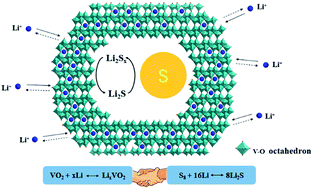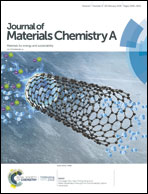The combination of intercalation and conversion reactions to improve the volumetric capacity of the cathode in Li–S batteries†
Abstract
Lithium–sulfur batteries are currently attracting wide interest due to their high theoretical capacity, although their energy density is greatly limited by the low tap density of traditional C/S cathode materials. Herein hollow VO2@S microspheres were designed as cathode materials with high volumetric capacity by combining the intercalation and conversion mechanisms. The hollow microsphere can offer enough space for high sulfur loading, which results in a high tap density of 1.64 g cm−3, while VO2 can offer additional capacity by Li intercalation reactions and has strong interactions with polysulfides to prevent the shuttling effect by its in situ surface sulfidation. Therefore, the obtained materials delivered a high volumetric capacity (1084 mA h cm−3 at 0.1C) and good rate capability and cycling performance (440 mA h g−1 at 1.0C after 200 cycles). This study demonstrates that traditional cathode materials with a proper potential window would be an alternative host for sulfur to offer additional capacity and increase the energy density due to their high tap density.



 Please wait while we load your content...
Please wait while we load your content...